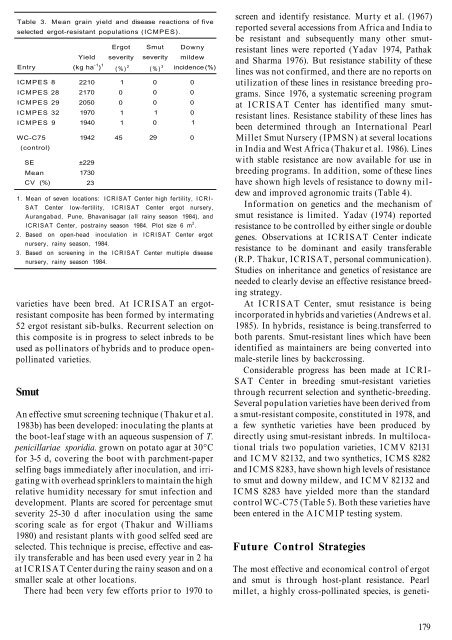RA 00110.pdf - OAR@ICRISAT
RA 00110.pdf - OAR@ICRISAT
RA 00110.pdf - OAR@ICRISAT
Create successful ePaper yourself
Turn your PDF publications into a flip-book with our unique Google optimized e-Paper software.
Table 3. Mean grain yield and disease reactions of five<br />
selected ergot-resistant populations (ICMPES).<br />
Entry<br />
ICMPES 8<br />
ICMPES 28<br />
ICMPES 29<br />
ICMPES 32<br />
ICMPES 9<br />
WC-C75<br />
(control)<br />
SE<br />
Mean<br />
CV (%)<br />
Yield<br />
(kg ha -1 ) 1<br />
2210<br />
2170<br />
2050<br />
1970<br />
1940<br />
1942<br />
±229<br />
1730<br />
23<br />
Ergot<br />
severity<br />
( % ) 2<br />
1<br />
0<br />
0<br />
1<br />
1<br />
45<br />
Smut<br />
severity<br />
( % ) 3<br />
0<br />
0<br />
0<br />
1<br />
0<br />
29<br />
Downy<br />
mildew<br />
incidence (%)<br />
1. Mean of seven locations: I C R I S A T Center high fertility, I C R I -<br />
S A T Center low-fertility, I C R I S A T Center ergot nursery,<br />
Aurangabad, Pune, Bhavanisagar (all rainy season 1984), and<br />
I C R I S A T Center, postrainy season 1984. Plot size 6 m 2 .<br />
2. Based on open-head inoculation in I C R I S A T Center ergot<br />
nursery, rainy season, 1984.<br />
3. Based on screening in the I C R I S A T Center multiple disease<br />
nursery, rainy season 1984.<br />
varieties have been bred. At ICRISAT an ergotresistant<br />
composite has been formed by intermating<br />
52 ergot resistant sib-bulks. Recurrent selection on<br />
this composite is in progress to select inbreds to be<br />
used as pollinators of hybrids and to produce openpollinated<br />
varieties.<br />
Smut<br />
An effective smut screening technique (Thakur et al.<br />
1983b) has been developed: inoculating the plants at<br />
the boot-leaf stage with an aqueous suspension of T.<br />
penicillariae sporidia. grown on potato agar at 30°C<br />
for 3-5 d, covering the boot with parchment-paper<br />
selfing bags immediately after inoculation, and irrigating<br />
with overhead sprinklers to maintain the high<br />
relative humidity necessary for smut infection and<br />
development. Plants are scored for percentage smut<br />
severity 25-30 d after inoculation using the same<br />
scoring scale as for ergot (Thakur and Williams<br />
1980) and resistant plants with good selfed seed are<br />
selected. This technique is precise, effective and easily<br />
transferable and has been used every year in 2 ha<br />
at ICRISAT Center during the rainy season and on a<br />
smaller scale at other locations.<br />
There had been very few efforts prior to 1970 to<br />
0<br />
0<br />
0<br />
0<br />
1<br />
0<br />
screen and identify resistance. Murty et al. (1967)<br />
reported several accessions from Africa and India to<br />
be resistant and subsequently many other smutresistant<br />
lines were reported (Yadav 1974, Pathak<br />
and Sharma 1976). But resistance stability of these<br />
lines was not confirmed, and there are no reports on<br />
utilization of these lines in resistance breeding programs.<br />
Since 1976, a systematic screening program<br />
at ICRISAT Center has identified many smutresistant<br />
lines. Resistance stability of these lines has<br />
been determined through an International Pearl<br />
Millet Smut Nursery (IPMSN) at several locations<br />
in India and West Africa (Thakur et al. 1986). Lines<br />
with stable resistance are now available for use in<br />
breeding programs. In addition, some of these lines<br />
have shown high levels of resistance to downy mildew<br />
and improved agronomic traits (Table 4).<br />
Information on genetics and the mechanism of<br />
smut resistance is limited. Yadav (1974) reported<br />
resistance to be controlled by either single or double<br />
genes. Observations at ICRISAT Center indicate<br />
resistance to be dominant and easily transferable<br />
(R.P. Thakur, ICRISAT, personal communication).<br />
Studies on inheritance and genetics of resistance are<br />
needed to clearly devise an effective resistance breeding<br />
strategy.<br />
At ICRISAT Center, smut resistance is being<br />
incorporated in hybrids and varieties (Andrews et al.<br />
1985). In hybrids, resistance is being.transferred to<br />
both parents. Smut-resistant lines which have been<br />
identified as maintainers are being converted into<br />
male-sterile lines by backcrossing.<br />
Considerable progress has been made at I C R I -<br />
SAT Center in breeding smut-resistant varieties<br />
through recurrent selection and synthetic-breeding.<br />
Several population varieties have been derived from<br />
a smut-resistant composite, constituted in 1978, and<br />
a few synthetic varieties have been produced by<br />
directly using smut-resistant inbreds. In multilocational<br />
trials two population varieties, I C M V 82131<br />
and I C M V 82132, and two synthetics, ICMS 8282<br />
and ICMS 8283, have shown high levels of resistance<br />
to smut and downy mildew, and I C M V 82132 and<br />
ICMS 8283 have yielded more than the standard<br />
control WC-C75 (Table 5). Both these varieties have<br />
been entered in the A I C M I P testing system.<br />
Future Control Strategies<br />
The most effective and economical control of ergot<br />
and smut is through host-plant resistance. Pearl<br />
millet, a highly cross-pollinated species, is geneti-<br />
179

















